|
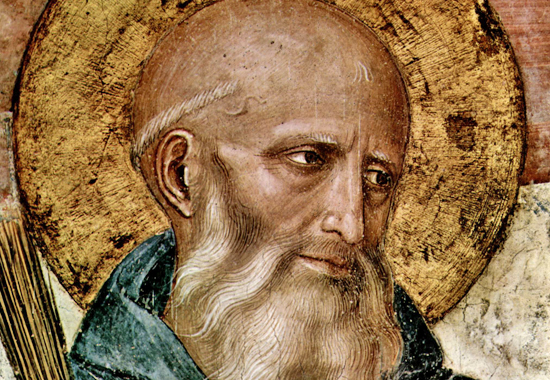
Saint Benedict of
Nursia 480-547
Benedict, the Benedictine Rule, and
its Order
|
|
Image
Above
Saint Benedict of
Nursia, detail of the fresco Crucifixion with
Saints by Fra Angelico, aka Beato Angelico,
aka Guido di Pietro, aka Giovanni da Fiesole,
take your pick.
The fresco was
created in 1441 / 1442 and you are invited to
examine it yourself at the National Museum of
San Marco, formerly the convent of San Marco, in
Florence, Italy. |
Here is the entire fresco. This mural covers some impressive
18 by 31 feet or 550 by 950 centimeters, hence the figures
are life-size.
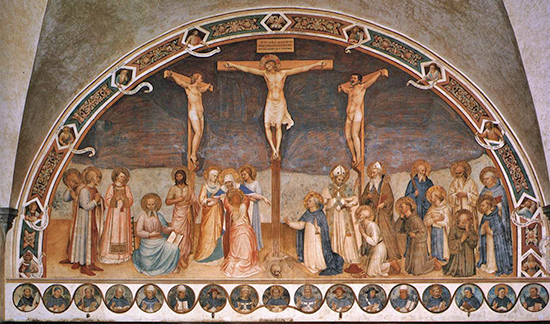
Crucifixion
With Saints by Fra Angelico
Museo Nazionale di San
Marco, Firenze
Click image to enlarge
And who exactly is in the crowd?
A cheerful blend of holy people.
Some never met as they were born into different
centuries. Here is the list:

The three men on the crosses you know
already — good thug to our left, Christ center, bad thug to
our right. Below them:
The group 1 to 4 to the left are local
saints and protectors of Florence and of the Medicis, which was the family that not only ruled Florence but also paid the bills for
renovations and wall-paintings at the San Marco convent. In detail we see:
1 — Saint
Damian and 2
— Saint Cosmas.
Christian martyrs Cosmas and Damian, the patron saints of physicians, might or might
not have been twins. In any event, and more importantly in this
context, Cosmas was also the patron saint of Cosimo de Medici, aka
Cosimo the Elder. Damian is turning away
in grief.
It is rumored
that this Saint Cosimo looks a little bit
like the painter's friend Nanni d'Antonio di
Banco, the sculptor.
3 — Saint Lawrence.
Christian
martyr and patron saint of Lawrence Medici,
aka Lorenzo the Elder, Cosimo's younger
brother. Saint Lawrence is easily to identify
because he travels with his gridiron on
which he is said to have been roasted to
death.
4 — Saint Mark.
Patron saint
of the local convent of San Marco and
evangelist. Appropriately, Mark points to
the open Gospel that he is holding and in
which he had written about Jesus' life and
death.
The group closest to Jesus on the cross is
the group 5 to 9, the two Johns and the
three Maries:
5 — Saint John the Baptist.
Christ's
forerunner, precursor, and herald. You get
the idea. John the Baptist prepared the
world for Christ's arrival. He therefore
seems a little bit detached from the active
mourning that takes place right next to him.
6 — Mary Salome
7 — Mary,
Jesus' mother, with spread arms that
indicate shier exhaustion, is assisted by
her friends left and right. Mary Magdalene
is kneeling in front of her for general
support because the lady is fainting.
8 — Little
John
The young
apostle John, the "disciple whom Jesus
loved," joining the mourning women.
9 — Mary
Magdalene
What's with the skull at the bottom of
the cross?
Sometimes also called the skull of
Adam, it reminds of death as the consequence
of sin, of which, on this day, Jesus became both — victim and
conqueror.
Group 10 to 20 to the right portrays a
party of founding saints of religious orders. Starting with the ones kneeling,
we see:
10 — Saint Dominic.
Dominic, who
was Domingo de Guzman because he was
Spanish, was the founder of the Dominicans.
11 — Saint Jerome.
Aka Eusebius
Hieronymus, who has his cardinal's hat thrown to the ground and
sports the traditional hermit outfit. Saint
Jerome was the
founder of the Order of St. Jerome, also called the Hieronymites.
Moreover, he
was the main translator of the Vulgate, which is
a major Latin
translation of the Bible.
12 — Saint Francis of Assisi.
Holding his
head in his hand, we see Saint Francis, the Founder of the
Franciscans in the traditional dress of the Franciscan monks. He
brought a cross and has the stigmata, which
is plural of stigma and a good thing if you are Catholic.
13 — Saint Bernard of Clairvaux.
A
famous Cistercian monk, Bernard was the founder of the monastery at Clairvaux.
Some say Bernard holds the rule of the
Order, others say it is the Gospel. Whatever
it is, Bernard likes his reading because he
holds it close to his chest.
14 — San Giovanni Gualberto.
Aka Saint
John Gualberto, or John Gualbert, the founder of a Benedictine
monastery at Vallombrosa, just outside of Florence. We see him
sobbing.
15 — Saint Peter Martyr.
Aka Peter of
Verona, patron saint of inquisitors. While on a
stroll, Peter was ambushed by members of the Cathari sect. Peter died on the
spot.
See also
 Assassinations in history.
Assassinations in history.
Standing in the row behind the ones kneeling,
are:
16 — Saint Ambrosius.
Aka Saint
Ambrose, bishop of Milan, dressed sharp in
official robe and authoritatively
accessorized with crozier to remember
Ambrose's formal scolding of Roman Emperor
Theodosius I the
Great, which occurred on more
than one occasion. By pointing to the cross
and looking at his book, Ambrosius calls
attention to what he feels should be
accepted as the true authorities in life.
However, some
say the 16 represents San Zanobi, or Saint
Zenobius, the first bishop of Florence, who
also had a very ritzy wardrobe.
17 — Saint Augustine.
Aka Saint
Augustine of Hippo, founder of the Augustinians. Saint Augustine
brought with him pen, notebook, and crozier,
to remind us of his substantial literary
output that had a powerful impact.
18 — Saint Benedict.
Our hero,
Saint Benedict, founder of the Benedictines,
author of the Rule of St. Benedict, with the
rod of penance in his hand. This reminds us
that in his Rule, Benedict had arranged for
institutionalized scourging in case of an
unrepentant offender. Voluntary flagellation
optional.
"Saint
Benedict is in deep meditation; but I know
not whether the Passion of the Lord or the
revival of monastic discipline in the West
has most of his thoughts." Marchese quote.
19 — Saint Romuald of Ravenna.
Founder
of the Camaldolese and resting on his cane due to advanced age.
20 — Saint Thomas Aquinas.
Major
Dominican theologian and philosopher.
The ensemble is surrounded by ten
people and a bird, each one holding up a slogan in Latin. That is one way of
looking at it.
Another one is:
Start examining the framing semicircle
with figure A and its
Latin text and then compare it with the figure directly opposite to
it, figure K and its Latin text.
A marks the beginning of Christ's
suffering and K marks the end of Christ's suffering. Between A and K
we find eight prophets who each contributes a detail of Christ's
life.
A — Dionysius the Areopagite,
Bible character and early
disciple who was recruited by Paul at Athens.
"Deus naturae
patitur" - "The God of Nature now suffers"
Dionysius is
mentioned in the Bible at Acts chapter 17,
verse 34. His quote is not. However, Church
folklore sees him at Heliopolis in Egypt at
the time of Jesus' death, where he witnessed
the supernatural solar eclipse and
commented:
"Aut Deus
naturae patitur, aut mundi machina
dissolvitur." - "Either the God of nature is
suffering, or the fabric of the world is
breaking up."
B — Daniel, prophet from the Bible
book of Daniel.
"Post
hedomadas VII et LXII occidet Chst" -
"After seven and sixty-two weeks Messiah
shall be cut off" - Bible quote from Daniel
chapter 9, verse 25 and 26.
C — Zechariah, prophet from the Bible
book of Zechariah.
"His plagatus
sum" - "I was wounded" - Bible
quote from Zechariah chapter 13, verse 6.
D — Jacob, aka Israel, Abraham's
grandson.
"Ad predan
fili mi ascendisti. Requiescens accubuisti
ut leo" - "From the prey, my son, you
will go up. He stooped down, he couched as a
lion" - Bible quote from Genesis chapter 49,
verse 9.
E — David, king of Jerusalem and hip harp
player.
"In siti mea
potaverunt me aceto" - "In my thirst
they gave me vinegar to drink" - Bible quote
from Psalms chapter 69, verse 21.
F — The Pelican.
"Similis factus
sum pelicano solitudinis" - "I am like a
pelican of the wilderness" - Bible quote
from Psalms chapter 102, verse 6.
Centered right above Christ is the
pelican, who, according to pre-Christian legend and completely
untrue
to pelican tradition, injures himself in order to feed
his blood to his young ones in times of food crisis and to thus ensure
their survival. The parallel to
Christ's self-sacrifice is clear.
More on the
pelican?
Of course.
Anybody fond
of symbolism loved this myth of the pelican, and Louisiana's Governor
William Wright
Heard was no exception. In 1902,
he made sure the State's seal would depict the following:
"A Pelican,
with its head turned to the left, in nest
with three young; the Pelican, following the
tradition in act of tearing its breast to
feed its young; around the edge of the seal
to be inscribed State of Louisiana. Over
head of the Pelican to be inscribed Union,
Justice, and under the Pelican to be
inscribed Confidence."
And here is the
good piece:
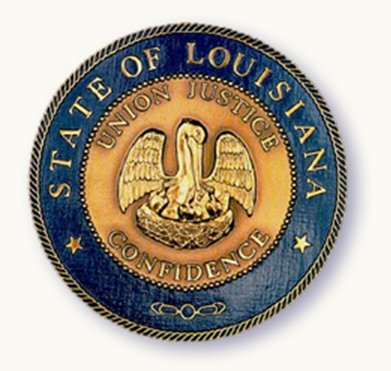
Louisiana's State
Bird - The Pelican
Back to Fra Angelico's wall painting,
and continuing clockwise after feathers we see:
G — Isaiah, prophet from the Bible
book of Isaiah.
"Vere
languores nostros, idem tulit et dolores
nostros" - "Surely our griefs he bore,
and our sorrows he carried" - Bible quote
from Isaiah chapter 53, verse 4.
H — Jeremiah, prophet from the Bible
book of Jeremiah.
"O Vos omnes
qui transitis per viam attendite et videte si
est dolor sicut dolor meus" - "All you
who pass by, look and see if there is any
sorrow like my sorrow." - Bible quote from
Lamentations chapter 1, verse 12.
I — Ezekiel, priest and prophet from
the Bible book of Ezekiel
"Exaltavi
lignum humile" - "I bare it upon my
shoulder" - Bible quote from Ezekiel chapter
12, verse 7.
J — Job, a god-fearing fellow singled
out for target practice by Satan the Devil himself, from the Bible
book of Job.
"Quis det
de carnibus eius ut saturemur" - "Who
will give us of his flesh that we may be
filled" - Bible quote from Job chapter 31,
verse 31.
K — Erythraean Sibyl
"Morte
morietur, tribus diebus somno subscepto et
tune ab inferis regressus ad lucem veniet primus"
- "Dying he shall die, and sleeping three
days, then shall he be the first returned
from hell to see the light."
Not a Bible
character per se, but a sibyl, which is a prophetess, from Erythrae
nonetheless. Erythrae, by the way, is a part of today's Turkey. Here is the map:
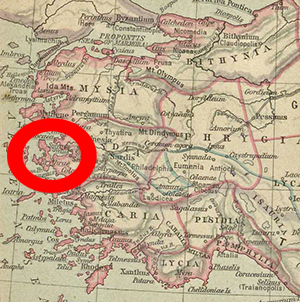
Map Location of Erythrae
Click to enlarge
Finally, we arrive at the bottom row
of Angelico's painting where we find 17 more faces:
At the center and with what seems to
be two gigantic shoelaces in his hands, Saint Dominic once again
because he already sat for the photo but also because the entire row
is occupied by prominent members of his, the Dominican, Order.
Experts tell us that shoelaces hadn't
been invented, and describe Dominic's props as branches of a tree
that join medallions, to which we eagerly reply, Who is portrayed?
From left to right we see:
1 - Far left: Buonianus, or
Buoninsegna, or Boninsegno, saint and martyr of Florence.
2 - Remigius of Florence, aka Beato
Remigio.
3 - Nicola Paglia da Giovinazzo, aka
Beato Niccolo, Provinciales Portugalesis.
4 - Jordanus of Germany, aka Jordan of
Saxon, aka Giordano, second general of the Order and a bishop.
5 - Saint Antonin, or Antoninus,
Archbishop of Florence. There used to be another person here, but
Antonin was painted over whoever it was.
6 - Cardinal Paul of Florence, aka
Beato Paolo, Patriarcha Gradensis.
7 - Cardinal Hugo of Florence, aka
Beato Ugone, who gave the eulogy at St. Dominic's funeral and was
the first cardinal of the Dominican Order.
8 - Pope Innocent V, of French origin
and the first Dominican pope.
9 - Center: St. Dominic.
10 - Pope Benedict XI of Treviso, was
pope for only one year and might or might not have been poisoned.
11 - Cardinal Giovanni Dominici of
Florence, also called Giandominico.
12 - Pietro della Pallude of France,
also spelled Pietro da Palude, Patriarch of Jerusalem.
13 - Albertus Magnus, aka Albert the
Great, of German origin.
14 - Saint Raimond of Catalonia, aka
Beato Raimondo, third general of the Order.
15 - Chiaro da Sesto of Florence, aka
Beato Chiaro, Provincialis Romanus.
16 - Saint Vincent Ferrer of Valencia,
aka San Vincenzio di Valenza.
17 - Far right: Bernard, aka Beato
Bernardo of Florence.
So...
This is the circle with which our monk Benedict is
generally associated.
Officially called
Saint
Benedict of Nursia, he was founder of the Benedictine
monastery in Monte Cassino, which you can visit today.
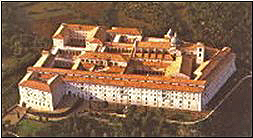
Abbey of Montecassino
And here is the
 official website of the Abby of Montecassino.
official website of the Abby of Montecassino.
Benedict wrote his
Regula Monachorum, also
called the Benedictine Rule,
on which the Order of Saint Benedict is based,
the house rules if you will.
On this map you can check the location of Nursia and Monte Cassino.
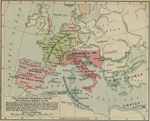
LOCATION OF NURSIA AND MONTE CASSINO, ITALY
Click map to enlarge
And here is the ecclesiastical map of the British Isles
and Western Europe in the Middle Ages, just in case you were
wondering:
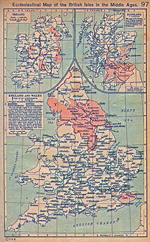
5th-13th Century British Isles Ecclesiastical
Click on map to enlarge
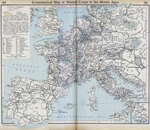
Western Europe Ecclesiastical 5th-13th Century
Click on map to enlarge
More History
|